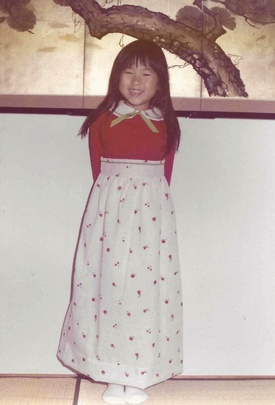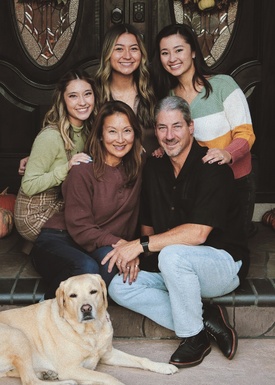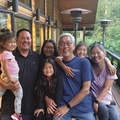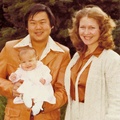In July, California State University Northridge senior Maren Elardo and her crew of fellow students in the Department of Cinema and Television Arts will begin filming her senior thesis film, “Ikigai.” Elardo’s film, along with three others, were selected through an intensive application process that involves submitting a 12-page story, and preparing a proposal that details the potential budget, visuals and crew.

“Ikigai” revolves around nine-year-old Mayumi, a Japanese American girl integrated into a primarily Caucasian school in the mid-1970s. In the first week of third grade, Mayumi’s mother, Hanako, unexpectedly shows up on show-and-tell day to teach nihon buyo, a classic Japanese dance. Initially, Mayumi is deeply embarrassed by her mother’s actions; but through her parents’ guidance, she is motivated to redo her show-and-tell in a way that honors her Japanese heritage.
The character of Mayumi is inspired by the experiences of Elardo’s own mother, Mayumi Elardo (formerly Nakaji), growing up in San Jose, California as a Sansei.
We caught up with Maren in June, at the start of her summer break.
* * * * *
JK: Tell us a little about yourself. Where were you born and raised?
ME: I was born in San Jose, California. I’m the youngest of three. My dad is Italian, and my mom is full Japanese. I got interested in film and television when I was really young.
My two older sisters — we used to make music videos, mess around, do fun stuff on iMovie, play with my mom’s camcorder. It just got me interested in making videos, making people laugh and entertaining other people. Then, when I was in middle school and high school, I started making videos with my friends.
When COVID-19 hit, I didn’t really know what I wanted to do. I found CSU Northridge, and I saw their film program and their cheer team (I’m also a cheerleader). They had everything I was looking for, so I applied and I got in.
I didn’t know that I had to apply on top of that to the film program, so luckily, I did get into the film program. Now I’m here!
JK: So you were a senior when COVID-19 hit?
ME: Yes, I graduated in 2020. I had all of those months until the end of the school year. That was when I had time to think about what I actually wanted to do.
I did originally want to be an actress. When I wanted to be an actress, I couldn’t find any Japanese American actors to look up to. It felt really discouraging, so I didn’t pursue that anymore. It shifted me into wanting to make opportunities for Japanese Americans and telling stories for Japanese actors to apply to and be a part of the project. That’s one of my reasons for this film too.
JK: The theme of our issue is representation. Did you feel represented in media growing up?
ME: No. It’s different for me too because I’m half Japanese. You don’t really see a lot of hapa people. The entertainment industry is definitely getting more progressive and there are a lot of Asian Americans as a whole, which is great; but I notice there are still not a lot of Japanese actors. I think it’s because there are no opportunities for them, and that’s just disappointing. I hope that there’s change for that in the future.
JK: The story is inspired by your mother, Mayumi, and her experience attending an integrated school in the 70s. Growing up, did your mom share her experiences with you?
ME: She never talked about being Japanese or the things that she went through as a kid with any of us. I think it was such a bad experience for her, that she hid it. Even today, she still has a hard time talking about the things she experienced, because it’s really impactful at such a young age when you go through bullying, discrimination, and racist comments from all your classmates.
It was during 2020 when she was telling me memories that she had from her childhood. It was crazy because the things she was telling me – it was the same things I experienced in elementary school — except she experienced it 40 years ago, and 40 years later, it was still happening. That’s a problem.
Making this story has caused her to talk more about it. [My mom] grew up in San Jose, too. She’s still living there right now. A lot of the people she went to elementary school with still live there.
They heard about this project. They read about it and heard it was based on her story. They’ve been kind of apologizing to her. “I’m so sorry we acted this way to you when we were kids. We didn’t know any better.” That’s another healing thing.
JK: In the film synopsis, you mentioned the character of Hanako, who is Mayumi’s mom. Is that character based on your grandmother?

ME: Yes, her name isn’t Hanako in real life; it’s Marjorie and her middle name is Sugako.
Hanako is a relative’s name. She actually did go to my mom’s classroom and teach a Japanese dance to the students. It was really embarrassing for my mom.
JK: This is your senior thesis film. You must’ve had so many ideas. How did you choose this story? Why do you feel like it’s important to share this story now?
ME: There were probably so many different paths I could have gone down. I chose a Japanese story because me and my mom … we have a hard time talking about our Japanese background because of the stuff we endured as [children].
I want things to change, and I do want to embrace my background a little bit more. I want there to be more representation for Japanese Americans.
JK: Can you explain what “ikigai” means to you? Why did you choose it as the name of your film?
ME: I really liked Ken Mogi’s definition of ikigai. He defined it as a spectrum. Every single person takes whatever they want from the concept and whatever they think is their ikigai, is their ikigai.
With this project, I made a Google Form that was anonymous. I shared it on Facebook, my mom shared it with her friends, it’s been on flyers I put around LA and San Jose. A bunch of people have sent in their ikigai and it’s just fascinating.
My takeaway from ikigai is what gets you up every morning. My ikigai is making an impact in my life[time]. I want to leave behind something that’s memorable and can make a change for other people. I think a lot of other people hope for that too, that they leave an impact on the world.
JK: What are you looking forward to bringing to life most in this film?
ME: I’m really excited to bring [nihon buyo] to life because it’s another educational thing for people when they’re watching the short film. Maybe they’ll want to research it a little bit more. I have talked to a few teachers of Japanese dance. It’s sad because not a lot of people are doing it anymore and it’s kind of fading away. It’ll be fun for the kids to see the actress doing it. She’s going to be in makeup, hair, and costume. They’re going to be getting the full experience!
JK: Are you getting a choreographer?
ME: Yes. My grandma has a lot of connections. This woman, Bando Hidesomi, has been helping me so much. I’m so grateful for her. She helped me pick out a dance we can do that fits the energy I’m looking for. She also has the costume, the music … She’s actually teaching her students the same dance right now. She’s helping me with the rehearsals with the actors. She’s a huge help.
On top of that, one of the actresses that auditioned for our project … she has 15 years of dance experience. At the end of our callback audition with her, I asked her if she would be open to helping me a little bit with the dance scenes. She said, “of course,” so I met with her on Zoom. She was giving me some insight and help on it. It’s going to be good. I’m excited.
JK: When the film is done, will it be streamed online?
ME: The film is owned by the school. A year from now, the film should be completely done. We submit it to the CSUN showcase. They choose from two different semesters of senior thesis films, so there are about eight films. They choose five of them to be screened at the showcase. Once that happens, we do a year-long festival run. After the year-long run, I think it’s public release. So, this is going to be a journey!
There are some ways to go around it. On our funder page, we have tiers. If you qualify and give a certain amount of money to the project, you get exclusive access to the film once it’s done. Other than that, it’s going to be a while. These films could be submitted to the Student Oscars. If [“Ikigai”] wins a student Oscar, it could go to the real Oscars! I’m hoping that’s going to happen, but who knows!
You can support and learn about “Ikigai” at ikigaishortfilm.com. Click on the “Funding” tab to view various online and offline donation options, as well as merchandise and fundraising opportunities.
*This article was originally published in The Hawai‘i Herald on June 16, 2023.
© 2023 Jackie Kojima






